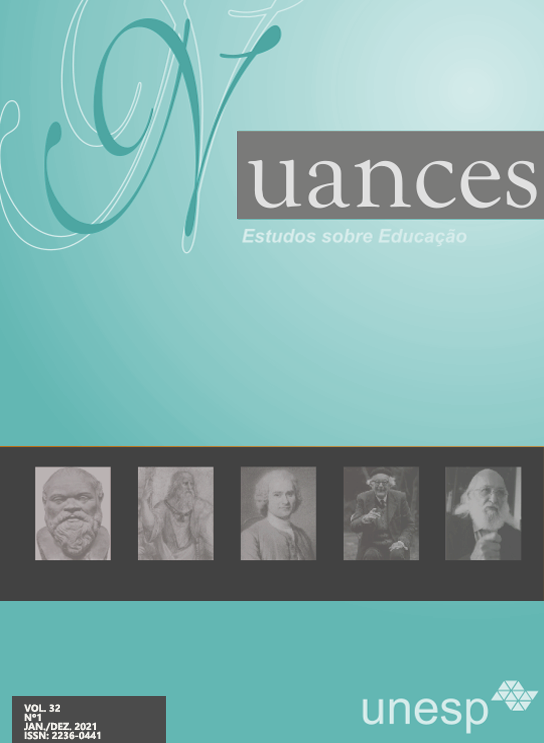El uso de tecnologías educativas para la formación de graduados en ingeniería
DOI:
https://doi.org/10.32930/nuances.v32i00.9124Palabras clave:
Tecnologías cognitivas, Educación en Ingeniería, Ingeniero de minasResumen
Este artículo corrobora la necesidad de formar a los socorristas de minas en un entorno profesional inmersivo con el uso de tecnologías cognitivas. Describe los elementos de este entorno y sugiere un modelo de cuatro módulos para la aplicación de las tecnologías cognitivas en la formación de los ingenieros de rescate de minas. Se presta especial atención a la necesidad de complementar armónicamente los métodos de construcción de una situación educativa y práctica con las técnicas de creación de un entorno inmersivo de aprendizaje interno. Las tecnologías cognitivas cumplen con muchas disposiciones de la norma concebir-diseñar-implementar-operar (CDIO) adoptada por la comunidad internacional y contienen un enorme campo de actividad para el desarrollo de tecnologías educativas tradicionales e innovadoras. Los conocimientos adquiridos en la formación teórica y la experiencia práctica adquirida en un entorno educativo inmersivo proporcionan mejor formación del personal de ingeniería adaptado al desempeño de sus tareas profesionales y a las necesidades de la producción.Descargas
Citas
ADLER, A. Style of life. Moscow: CheRo, 2000.
ANDERSEN, J. R. Cognitive Psychology and its Implications. 5. ed. New York: Worth Publishers, 2002.
BAKIN, M. V. Immersivnye tehnologii v razvitii socialʹnoj èmpatii i obrazovanija [Immersive technologies in the development of social empathy and education]. Meždunarodnyj Naučno-issledovatel’skij Žurnal [International Research Journal], Yekaterinburg, n. 10(100), p. 16-19, 2020. https://doi.org/10.23670/IRJ.2020.100.10.037
CUMMINGS, J. J.; BAILENSON, J. N. How Immersive Is Enough? A Meta-Analysis of the Effect of Immersive Technology on User Presence. Media Psychology, Athens, v. 19, n. 2, p. 272-309, 2016. https://doi.org/10.1080/15213269.2015.1015740
DAVYDOVA, Z. E. Modernization of training of engineers in basic disciplines on the example of studying electrical engineering. In: INTERNATIONAL SCIENTIFIC AND PRACTICAL CONFERENCE MODERNIZATION OF ENGINEERING EDUCATION: RUSSIAN TRADITIONS AND MODERN INNOVATIONS, 2017, Yakutsk. Proceedings […]. Yakutsk: NEFU Publishing House, 2017. p. 192-195.
DUBROVSKAYA, Y. A.; PIKHKONEN, L. V. Professionalʹno-prikladnaja fizičeskaja podgotovka kak osnova dlja formirovanija praktičeskih kompetencij obučajuŝihsja v vuzah silovyh vedomstv (na primere vuzov MČS Rossii) [Professionally Applied Physical Training as the Basis for the Formation of Practical Competencies of Students in the Universities of Law Enforcement Agencies (on the Example of Universities EMERCOM of Russia)]. Obrazovanie. Nauka. Naučnye Kadry [Education. Science. Scientific Personnel], n. 4, p. 174-181, 2019. https://doi.org/10.24411/2073-3305-2019-10213
DUBROVSKAYA, Y. A.; PIKHKONEN, L. V.; RUDENKO, G. V. Organizacionno-metodičeskij opyt praktičeskoj podgotovki studentov-gornospasatelej [Organizational and methodological experience of practical training of students-mountain rescuers]. Uchenye zapiski universiteta imeni P.F. Lesgafta [Scientific Notes of P.F. Lesgaft University], n. 8(186), p. 105-113, 2020. https://doi.org/10.34835/issn.2308-1961.2020.8.p105-113
GONCHAROVA, O.; MOMOT, M. Polnoe pogruženie: kak immersivnoe obučenie prihodit v kompanii i školy [Total Immersion: How Immersive Learning Comes to Companies and Schools]. Рбк [RBC], 2019. Available: https://trends.rbc.ru/trends/education/5d6fb3449a794781b981b437. Access: 24 Mar. 2021.
KORNILOV, Y. V. Immersivnyj podhod v obrazovanii [Immersive approach in education]. Azimuth of Scientific Research: Pedagogy and Psychology, Togliatti, v. 8, n. 1(26), p. 174-178, 2019. https://doi.org/ 10.26140/anip-2019-0801-0043
KRAYUSHKIN, N. Virtualʹnaja realʹnostʹ v obrazovanii [Virtual reality in education]. Graduate School of Business: Center for the development of competencies in business informatics, 2021. Available: https://hsbi.hse.ru/articles/virtualnaya-realnost-v-obrazovanii/. Access: 24 Mar. 2021.
LI, D.; FENG, Y.; CHENG, D.; LU, Y. Exploration and Research on the Engineering Education Model of “Practicing while Teaching with Curriculum Integration”. IOP Conference Series: Materials Science and Engineering, v. 466, 012019, 2018. https://doi.org/10.1088/1757-899X/466/1/012019
POTANINA, O. V. Kognitivnaja kompetencija buduŝego inženera: suŝnostʹ, struktura, soderžanie [Cognitive competence of future engineer: essence, structure, content]. Vestnik Baškirskogo Universiteta [Bulletin of Bashkir University], Ufa, v. 14, n. 1, p. 298-301, 2009.
POTKONJAK, V.; GARDNER, M.; CALLAGHAN, V.; MATTILA, P.; GUETL, C.; PETROVIĆ, V. M.; JOVANOVIĆ, K. Virtual laboratories for education in science, technology, and engineering: A review. Computers & Education, Tempe, v. 95, p. 309-327, 2016. https://doi.org/10.1016/j.compedu.2016.02.002
RADIONOVSKAYA, T. I.; BAEVA, L. S. Praktičeskaja podgotovka kak osnovopolagajuŝij faktor formirovanija professionalʹnyh kompetencij [Practical training as a fundamental factor in the formation of professional competences]. Modern Problems of Science and Education, Moscow, n. 6, p. 973, 2014. Available: http://science-education.ru/ru/article/view?id=17175. Access: 24 Mar. 2021.
SCHEXNAYDER, C.; ANDERSON, S. Construction Engineering Education: History and Challenge. Journal of Construction Engineering and Management, v. 137, n. 10, p. 730-739, 2011. https://doi.org/10.1061/(ASCE)CO.1943-7862.0000273
SERGEEV, S. F. Education in global information-communication and anthropogenic environment: new opportunities and limits. Open Education, v. 1, n. 96, p. 32-39, 2013.
SERGEEV, S. F. Virtual simulators: Problems of theory and methodology of design. Human-Machine Systems, v. 2, n. 8, p. 15-20, 2010.
SERGEEV, S. F.; BERSHADSKY, M. E.; CHOROSOVA, O. M.; SOLOMONOVA, G. S.; ZHOHIKOV, A. V.; GERASIMOVA, R. E.; ZAKHAROVA, N. I.; NIKULINA, A. A.; SAVKIN, P. A. Cognitive pedagogy: E-learning technologies in teacher professional development: Monograph. Yakutsk: Publishing house of the Institute for Humanitarian Research and Problems of Indigenous Peoples of the North, Siberian Branch of the Russian Academy of Sciences, 2016.
TEJEDOR, G.; SEGALÀS, J.; ROSAS-CASALS, M. Transdisciplinarity in higher education for sustainability: How discourses are approached in engineering education. Journal of Cleaner Production, Brno, v. 175, p. 29-37, 2018. https://doi.org/10.1016/j.jclepro.2017.11.085
TVKINORADIO. Immersive environment technology: a combination of the old and the new. Information and technical portal. n.d. Available: https://tvkinoradio.ru/article/article13941-tehnologiya-immersivnoj-sredi-splavstarogo-i-novogo. Access: Mar. 24, 2021.
VESHNEVA, I. V.; SINGATULIN, R. A. Virtual technologies – New perspectives in the learning system. Information Technologies in Education, v. 43, p. 382-387, 2015.
VOROBYOVA, I. M. Strengthening the role of engineering education and the practical component of educational programs in a technical university. Young Scientist, v. 11, n. 91, p. 1304-1307, 2015.
ZAIR-BEK, E. S. The future of education: How immersive technologies will change learning forever. St. Petersburg: The Herzen State Pedagogical University of Russia, 2018.
Publicado
Cómo citar
Número
Sección
Licencia
Atribuição-NãoComercial
CC BY-NC
Esta licença permite que outros remixem, adaptem e criem a partir do seu trabalho para fins não comerciais, e embora os novos trabalhos tenham de lhe atribuir o devido crédito e não possam ser usados para fins comerciais, os usuários não têm de licenciar esses trabalhos derivados sob os mesmos termos.





